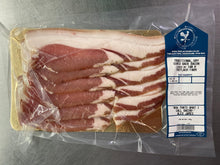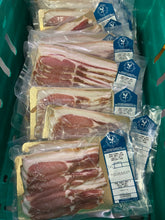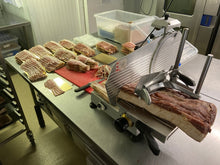Dry Cured Bacon from Treflach Farm
Regular price
£5.00
Sale
All our bacon is handmade on the farm from our own pork by Ian the farmer. The streaky bacon is smoked here at Treflach, again by Ian, in his homemade smoker!
Traditionally dry cured; there's no shrinkage in the pan (that's due to water escaping from cheap bacon) and no horrible white stuff (that's salt from when bacon is injected with brine) when you cook it.
We make our bacon in batches when pork is available so usually available frozen. If you would prefer fresh please get in contact.
Weight minimum 200g.
In case you're interested...
Nitrates and Nitrites in Treflach Farm Bacon & Gammon
Let’s be clear. We always start with great ingredients
In our sausages, bacon and ham we only use pork from pigs born and raised on Treflach Farm. Yes, this means the pork does cost us more, which in turn costs you more but you know what you are getting.
Dry-cured and Apple Wood smoked
We dry-cure our bacon. There are various methods of curing bacon to give it its taste and colour. The time-honoured method is to cure the pork in salt, along with herbs and spices, for a period of time – several days to several weeks.
Technological advances have dramatically reduced the time required. To us, that’s not always a good thing. Many bacon manufacturers “pump” a liquid cure directly into the pork, with a meat injector very fine needles to inject the cure, cutting the cure time down to a few hours.
We don’t pump a cure into our pork or use a liquid cure – we let our dry cure do its work over time. It’s why we guarantee our bacon won’t boil in its juices and shrink from the loss of added liquid, when you cook it. Of course, adding liquid adds weight to the bacon, so when you buy some bacon you’re also paying for water.
After dry-curing, we smoke the streaky bacon using apple wood woodchips, to give it a fantastic colour and delicious flavour. That’s us: quality ingredients, ethically raised animals, traditional dry-cured and apple wood smoked.
Let’s talk about preservatives and the topic of the use of nitrates and nitrites. There’s been a fair bit of discussion on this recently, and over the last 100 years, for that matter. Here’s what we’ve learned from making bacon for 15 years.
The nitrate debate
In the meat curing process, nitrates and nitrites are salts that are used to cure and preserve meats. They have been in use for hundreds of years. No-one is quite sure when it all started but there is strong evidence that it was first used around in the 10th century BC, as a natural contaminant in the sea and mined salt that butchers were using to salt meats.
These salts remove much of the moisture from the meat and prevent the growth of bacteria – particularly the very nasty botulinum toxin produced by Clostridium botulinum, which we know as Botulism.
The other important thing to know is that nitrate serves as a ‘precursor’ to nitrite in the meat curing process. In other words, during curing the nitrate turns into nitrite. It’s the nitrite that cures the meat, gives it its flavour and colour, and preserves it.
A closer look at nitrates
It’s important to know that nitrate occurs naturally in green vegetables, and in high concentrates in some vegetables such as celery. Studies estimate that approximately 80% of people’s daily intake of nitrate is primarily from plant foods, fruit and water. The other interesting fact is that saliva accounts for 93% of the total daily intake of nitrate by humans. It all means that people have been absorbing nitrate since we first walked on the earth.
So what’s the issue?
It is not the nitrates and the nitrites in the meat curing process that cause the issue. It is the chemical reactions they can cause that is the problem. One of these chemical reactions can cause nitrosamines to form and it is the formation of these that have been linked to causing cancer cells.
Green vegetables contain antioxidants, which keep the nitrosamines under control. But when it comes to producing bacon the use of nitrites and nitrates in the production of bacon is a little trickier.
It was also discovered that when bacon was heated to over 130 Degrees Celsius there was more likelihood of nitrosamines being formed – a really good reason not to burn your bacon!
Ask the experts
To track down good, reliable information about nitrates, nitrites and nitrosamines, we wanted to see what technical experts and food regulators around the world had to say.
Interestingly, we couldn’t find any guidelines from the UK covering the issue of nitrosamines in bacon. However, the USA’s regulators, the Food and Drug Administration (FDA), do have some guidelines.
We found out that the FDA finally settled on a standard that does not permit the use of nitrate in bacon so that the concentrations of nitrite can be controlled more precisely.
The FDA also requires that bacon has sodium erythorbate, sodium asorbate or ascorbic acid (Vitamin C or E300) added to the cure, regardless of curing method to inhibit the potential for the formation of nitrosamines during frying, oven baking or barbecuing.
Here at Treflach Farm we have adopted this standard – adding vitamin C (E300) to keep the nitrosamines under control. Of course, we still don’t recommend that you eat several kilos of bacon a day!
How about nitrite and nitrate free bacon?
Nitrate occurs naturally in vegetables, particularly in celery. A number of bacon manufactures use celery powder, or other plant extracts, instead of sodium nitrite.
During the curing process the nitrate in the celery powder still creates nitrite. And there is no difference between the nitrite created by the celery powder and the nitrite created by sodium nitrate. Nitrite is nitrite regardless of where it comes from.
This is where it gets a little tricky.
Most countries allow bacon manufacturers to advertise their bacon as “Nitrite Free” bacon where they have used a natural nitrate like celery powder to make their bacon. And, there is nothing on the labelling to advise the customer that there is really no difference between this bacon and bacon made with sodium nitrite.
On the other hand, some bacon is made without natural or introduced nitrates and nitrites. This bacon is often rather grey in colour. In very recent times there have been a few companies who have been able to replicate the distinctive red colour of bacon though other methods. The big question is do these still taste like bacon?
Will we make bacon using natural nitrates?
Well, probably not, because the end result is that the bacon will still contain nitrites. Will we make “real” nitrite-free bacon? Yes, we’ll probably have a go at it in or spare time and see if we can get one that looks and tastes as good as our current bacon. We'll keep you posted!







